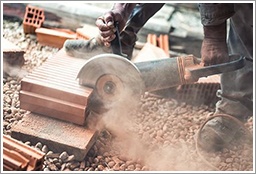 We're often asked, "How do I know if there is silica exposure on my job site?" While there is a variety of testing that can be done, you can start with 2 basic questions:
We're often asked, "How do I know if there is silica exposure on my job site?" While there is a variety of testing that can be done, you can start with 2 basic questions:
- What tasks are being done?
- What tools are onsite?
Common Tasks that Risk Exposure to Respirable Crystalline Silica
- Abrasive blasting
- Tuckpoint grinding
- Surface grinding
- Drilling and coring
- Jack hammering
- Chipping
- Cutting and polishing concrete/brick/granite/stone/tile
- Milling
- Excavating
Common Tools that Risk Exposure to Respirable Crystalline Silica
When the tools listed below are used on concrete, brick, block, stone, mortar, and other materials that contain crystalline silica there is an increased exposure.
- Stationary masonry saws
- Handheld power saws
- Walk-behind saws
- Drivable saws
- Rig-mounted core saws or drills
- Handheld and stand-mounted drills (including impact and rotary hammer drills)
- Dowel drilling rigs
- Vehicle-mounted drilling rigs
- Jackhammers and handheld powered chipping tools
- Handheld grinders
- Walk-behind milling machines and floor grinders
- Drivable milling machines
- Crushing machines
- Heavy equipment and utility vehicles when used to abrade or fracture silica-containing materials (such as hoe-ramming or rock ripping) or during demolition activities, and for tasks such as grading and excavating
When you've identified your risk, or are wondering your level of risk, the next step is to develop a strategic plan to keep your crew safe. Keep in mind, it's not just about the task at-hand, it's also about what is going on around you. Contact your KnowledgeBroker or safety@rrins.com to start the discussion.

